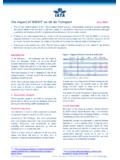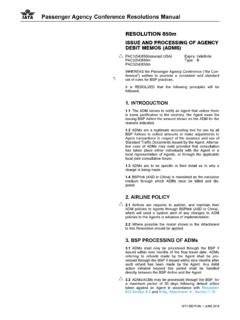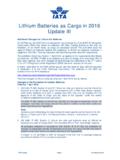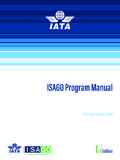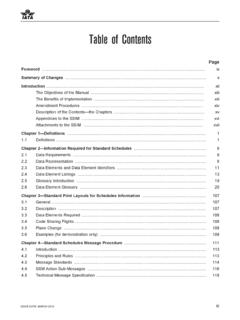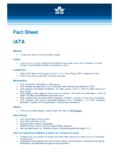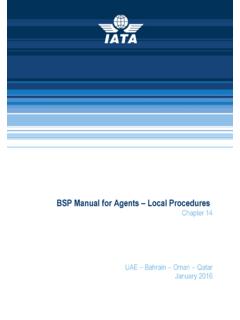Transcription of PASSENGERS TRAVELLING WITH LITHIUM BATTERIES
1 Carriage of portable electronic devices (PED), portable medical electronic devices (PMED) and spare BATTERIES by PASSENGERS is dependent on the Watt-hour (Wh) rating for LITHIUM ion (rechargeable) BATTERIES or the LITHIUM metal content for non-rechargeable the below table to determine if your PED, PMED or spare battery(ies) can be Each person is limited to a maximum of 15 PED. The operator may approve the carriage of more than 15 Each person is limited to a maximum of 20 spare BATTERIES of any type. The operator may approve the carriage of more than 20 rating or LITHIUM metal contentConfigurationCarry-on baggageChecked baggageOperator approval 100 Wh / 2gIn equipment (PED or PMED)Yes (max 15 PED/PMED1)Ye sNo1 Spare battery(ies)Yes (max 20 spare batteries2)NoNo2>100 to 160 WhIn equipment (PED or PMED)Ye sYe sYe sSpare battery(ies)Yes (max 2 spare BATTERIES )NoYe s>16 0 WhMust be prepared and carried as cargo in accordance with the IATA Dangerous Goods Regulations> 2g 8gIn equipment (PMED only)Ye sYe sYe sSpare BATTERIES for PMEDYes (max 2 spare BATTERIES )NoYe sPASSENGERS TRAVELLING WITH LITHIUM BATTERIES2018 Portable electronic devices (PED)
2 Containing batteriesPEDs, which may include electronics such as cameras, mobile phones, laptops and tablets containing BATTERIES , when carried by PASSENGERS for personal use, should be carried in carry-on devices are carried in checked baggage: measures must be taken to protect the device from damage and to prevent unintentional activation; the device must be completely switched off (not in sleep or hibernation mode).Spare LITHIUM batteriesSpare BATTERIES must be individually protected to prevent short circuits by placement in the original retail packaging or by otherwise insulating terminals, by taping over exposed terminals or placing each battery in a separate plastic bag or protective pouch and carried in carry-on baggage only.
3 Articles containing LITHIUM cells or BATTERIES , the primary purpose of which is to provide power to another device, power banks, are considered as spare BATTERIES and are restricted to carry-on baggage must be of a type that meets the requirements of the UN Manual of Tests and Criteria, Part III, subsection cigarettes containing BATTERIES e-cigarettes Electronic cigarettes including e-cigars and other personal vaporizers containing BATTERIES when carried by PASSENGERS for personal use must be in carry-on baggage only. Recharging of these devices and/or BATTERIES on board the aircraft is not permitted and the passenger must take measures to prevent accidental activation. Baggage with integrated LITHIUM BATTERIES smart luggage These devices could include integrated LITHIUM BATTERIES , motors, power banks, GPS, GSM, Bluetooth, RFID or Wi-Fi technology.
4 The presence of the LITHIUM BATTERIES can contravene various regulatory requirements. Examples of smart luggage include features such as: LITHIUM ion battery and motor allowing it to be used as a personal transportation device. LITHIUM ion battery power bank that allows charging of other electronic devices. GPS tracking devices with or without GSM capability. Bluetooth, RFID and Wi-Fi portable electronic devices (PED) carried on an aircraft are subject to specific requirements to ensure that they do not pose a hazard to aircraft systems due to electromagnetic equipped with a LITHIUM battery, other than LITHIUM button cells: If the baggage is to be checked in, the LITHIUM battery must be removed from the baggage and the LITHIUM battery must be carried in the cabin; or The baggage must be carried in the cabin.
5 Baggage where the LITHIUM battery is designed to charge other devices and cannot be removed is forbidden for contact your carrying airline in advance of travel as they may impose additional restrictions. For more information, please visit 2 effective April 2018

